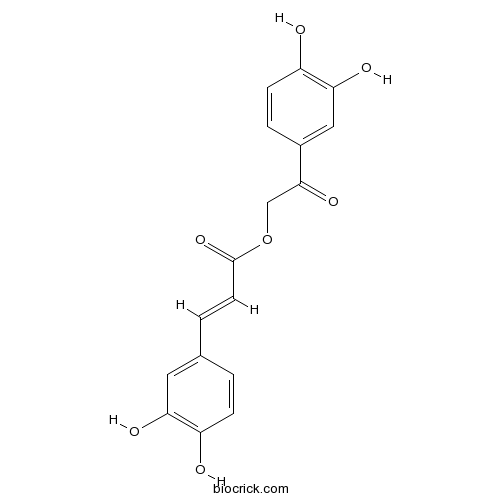PetasiphenoneCAS# 162616-81-1 |

Quality Control & MSDS
3D structure
Package In Stock
Number of papers citing our products

| Cas No. | 162616-81-1 | SDF | Download SDF |
| PubChem ID | 16066851 | Appearance | Powder |
| Formula | C17H14O7 | M.Wt | 330.29 |
| Type of Compound | N/A | Storage | Desiccate at -20°C |
| Synonyms | 3,4-Dihydroxyphenacyl caffeate;3,4-Dihydroxy-phenacyl caffeate | ||
| Solubility | Soluble in Chloroform,Dichloromethane,Ethyl Acetate,DMSO,Acetone,etc. | ||
| Chemical Name | [2-(3,4-dihydroxyphenyl)-2-oxoethyl] (E)-3-(3,4-dihydroxyphenyl)prop-2-enoate | ||
| SMILES | C1=CC(=C(C=C1C=CC(=O)OCC(=O)C2=CC(=C(C=C2)O)O)O)O | ||
| Standard InChIKey | DPMVCMFEBYVTFB-QHHAFSJGSA-N | ||
| Standard InChI | InChI=1S/C17H14O7/c18-12-4-1-10(7-14(12)20)2-6-17(23)24-9-16(22)11-3-5-13(19)15(21)8-11/h1-8,18-21H,9H2/b6-2+ | ||
| General tips | For obtaining a higher solubility , please warm the tube at 37 ℃ and shake it in the ultrasonic bath for a while.Stock solution can be stored below -20℃ for several months. We recommend that you prepare and use the solution on the same day. However, if the test schedule requires, the stock solutions can be prepared in advance, and the stock solution must be sealed and stored below -20℃. In general, the stock solution can be kept for several months. Before use, we recommend that you leave the vial at room temperature for at least an hour before opening it. |
||
| About Packaging | 1. The packaging of the product may be reversed during transportation, cause the high purity compounds to adhere to the neck or cap of the vial.Take the vail out of its packaging and shake gently until the compounds fall to the bottom of the vial. 2. For liquid products, please centrifuge at 500xg to gather the liquid to the bottom of the vial. 3. Try to avoid loss or contamination during the experiment. |
||
| Shipping Condition | Packaging according to customer requirements(5mg, 10mg, 20mg and more). Ship via FedEx, DHL, UPS, EMS or other couriers with RT, or blue ice upon request. | ||

Petasiphenone Dilution Calculator

Petasiphenone Molarity Calculator
| 1 mg | 5 mg | 10 mg | 20 mg | 25 mg | |
| 1 mM | 3.0276 mL | 15.1382 mL | 30.2764 mL | 60.5528 mL | 75.6911 mL |
| 5 mM | 0.6055 mL | 3.0276 mL | 6.0553 mL | 12.1106 mL | 15.1382 mL |
| 10 mM | 0.3028 mL | 1.5138 mL | 3.0276 mL | 6.0553 mL | 7.5691 mL |
| 50 mM | 0.0606 mL | 0.3028 mL | 0.6055 mL | 1.2111 mL | 1.5138 mL |
| 100 mM | 0.0303 mL | 0.1514 mL | 0.3028 mL | 0.6055 mL | 0.7569 mL |
| * Note: If you are in the process of experiment, it's necessary to make the dilution ratios of the samples. The dilution data above is only for reference. Normally, it's can get a better solubility within lower of Concentrations. | |||||

Calcutta University

University of Minnesota

University of Maryland School of Medicine

University of Illinois at Chicago

The Ohio State University

University of Zurich

Harvard University

Colorado State University

Auburn University

Yale University

Worcester Polytechnic Institute

Washington State University

Stanford University

University of Leipzig

Universidade da Beira Interior

The Institute of Cancer Research

Heidelberg University

University of Amsterdam

University of Auckland

TsingHua University

The University of Michigan

Miami University

DRURY University

Jilin University

Fudan University

Wuhan University

Sun Yat-sen University

Universite de Paris

Deemed University

Auckland University

The University of Tokyo

Korea University
- Soyasaponin II
Catalog No.:BCN1418
CAS No.:55319-36-3
- Atherosperminine
Catalog No.:BCN8208
CAS No.:5531-98-6
- Costunolide
Catalog No.:BCN5740
CAS No.:553-21-9
- Xanthyletin
Catalog No.:BCN6722
CAS No.:553-19-5
- Thonzonium Bromide
Catalog No.:BCC5636
CAS No.:553-08-2
- Tiamulin
Catalog No.:BCC9179
CAS No.:55297-95-5
- (Z)-Falcarindiol
Catalog No.:BCN8495
CAS No.:55297-87-5
- Atractylodin
Catalog No.:BCN6292
CAS No.:55290-63-6
- Praziquantel
Catalog No.:BCC4829
CAS No.:55268-74-1
- MnTBAP Chloride
Catalog No.:BCC6477
CAS No.:55266-18-7
- Boc-Gln(Xan)-OH
Catalog No.:BCC3385
CAS No.:55260-24-7
- A-674563
Catalog No.:BCC3903
CAS No.:552325-73-2
- Beclomethasone dipropionate
Catalog No.:BCC4257
CAS No.:5534-09-8
- Vidarabine
Catalog No.:BCC4877
CAS No.:5536-17-4
- Baohuoside II
Catalog No.:BCN2888
CAS No.:55395-07-8
- Hydroxyisoleucine
Catalog No.:BCN8402
CAS No.:55399-93-4
- Lithium carbonate
Catalog No.:BCC7970
CAS No.:554-13-2
- Methazolamide
Catalog No.:BCC2318
CAS No.:554-57-4
- Deferasirox Fe3+ chelate
Catalog No.:BCC1521
CAS No.:554435-83-5
- 8beta-(4-Hydroxytigloyloxy)ovatifolin
Catalog No.:BCN7122
CAS No.:554449-27-3
- Boc- D-1-Nal-OH
Catalog No.:BCC3283
CAS No.:55447-00-2
- Anisodamine hydrobromide
Catalog No.:BCC8119
CAS No.:55449-49-5
- Z-Asp(OtBu)-OH.H2O
Catalog No.:BCC2789
CAS No.:5545-52-8
- Chimonanthine
Catalog No.:BCN7824
CAS No.:5545-89-1
Petasiphenone, a phenol isolated from Cimicifuga racemosa, in vitro inhibits proliferation of the human prostate cancer cell line LNCaP.[Pubmed:17295185]
Planta Med. 2007 Feb;73(2):184-7.
Extracts of Cimicifuga racemosa (L.) Nutt. (syn.: Actaea racemosa L.) (CR) inhibit the proliferation of the human prostate cancer cell line LNCaP. Recently, the phenylpropanoid ester 3,4-dihydroxyphenacyl caffeate (Petasiphenone, 1) was isolated from CR. This substance is a structural homologue to petasiphenol ([3-(3,4-dihydroxyphenyl)-2-oxopropyl caffeate]), a compound produced by Petasites japonicus Sieb. & Zucc. which inhibits the growth of various human leukemia cell lines. Because of the structural similarity, we examined whether 1 affects the proliferation of LNCaP cells and the secretion of prostate-specific antigen (PSA). Under basal conditions as well as under co-incubation with 10 nM estradiol [E2 or 1 nM dihydrotestosterone (DHT)], 1 dose-dependently inhibited proliferation of LNCaP cells while PSA release per cell was not altered. We report for the first time that a defined compound isolated from CR inhibits the growth of the human prostate cancer cells LNCaP.


